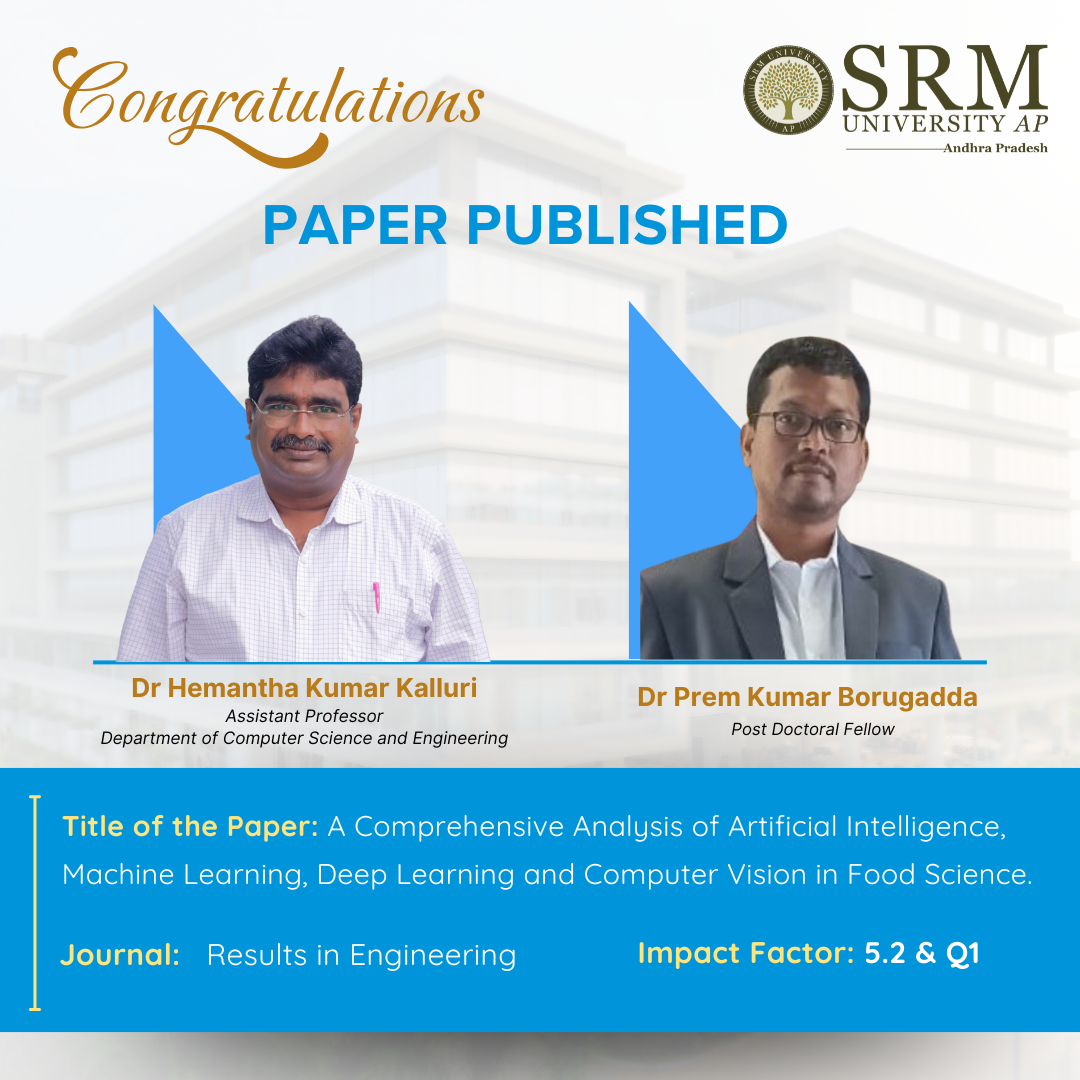 Assistant Professor Dr Hemantha Kumar Kalluri from the Department of Computer Science and Engineering and post-doctoral fellow, Dr Premkumar Borugadda have published a research paper titled, A Comprehensive Analysis of Artificial Intelligence, Machine Learning, Deep Learning and Computer Vision in Food Science. This significant research explores how Artificial Intelligence (AI), Machine Learning (ML), Deep Learning (DL), and Computer Vision (CV) are making food processing smarter and more reliable.
Assistant Professor Dr Hemantha Kumar Kalluri from the Department of Computer Science and Engineering and post-doctoral fellow, Dr Premkumar Borugadda have published a research paper titled, A Comprehensive Analysis of Artificial Intelligence, Machine Learning, Deep Learning and Computer Vision in Food Science. This significant research explores how Artificial Intelligence (AI), Machine Learning (ML), Deep Learning (DL), and Computer Vision (CV) are making food processing smarter and more reliable.
Here’s a brief on their findings and the social and practical implementations of their work.
A Brief Abstract
Providing safe and quality food is crucial for every household and is of extreme significance in the growth of any society. It is a complex procedure that deals with all issues focusing on the development of food processing from seed to harvest, storage, preparation, and consumption. This current paper seeks to demystify the importance of Artificial Intelligence (AI), Machine Learning (ML), Deep Learning (DL), and Computer Vision (CV) in ensuring food safety and quality. By stressing the importance of these technologies, the audience will feel reassured and confident in their potential. These are very handy for such problems, giving assurance over food safety. CV is incredibly noble in today’s generation because it improves food processing quality and positively impacts firms and researchers. Thus, at the present production stage, rich in image processing and computer visioning is incorporated into all facets of food production. In this field, DL and ML are implemented to identify the type of food in addition to quality. Concerning data and result-oriented perceptions, one has found similarities regarding various approaches. As a result, the findings of this study will be helpful for scholars looking for a proper approach to identify the quality of food offered. It helps to indicate which food products have been discussed by other scholars and lets the reader know papers by other scholars inclined to research further. Also, deep learning is accurately integrated with identifying the quality and safety of foods in the market. This paper describes the current practices and concerns of ML, DL, and probable trends for its future development.
Explanation of the Research in Layperson’s Terms
The research explores how Artificial Intelligence (AI), Machine Learning (ML), Deep Learning (DL), and Computer Vision (CV) are making food processing smarter and more reliable.
AI and ML in Food Processing
- AI-powered systems can predict food spoilage, detect harmful contaminants, and ensure food is stored at the right temperature.
- ML models learn from past data to improve food quality, making processing more efficient and reducing waste.
Computer Vision (CV) for Food Inspection
- Cameras powered by AI can analyse food products and detect defects, ensuring only high-quality food reaches consumers.
- CV helps in sorting fruits and vegetables based on size, colour, and ripeness, reducing human error and speeding up production.
- It is also used to check food packaging for defects and prevent contamination.
Deep Learning for Better Food Safety
- Deep learning, a more advanced type of AI, helps identify patterns in food quality data.
- It is used to detect food adulteration (unwanted substances added to food), ensuring that the food we consume is pure and safe.
- DL models can also classify different types of food and analyse their nutritional content.
Future of Smart Food Processing
- As AI and ML continue to evolve, food production will become more automated, reducing human labour while increasing efficiency.
- These technologies will help minimise food waste, improve supply chains, and provide personalised nutrition recommendations.
- By integrating AI with real-time monitoring, food safety can be ensured on a global scale.
Practical Implementation and Social Implications
The research on Artificial Intelligence (AI), Machine Learning (ML), Deep Learning (DL), and Computer Vision (CV) in Food Science has significant real-world applications and social implications:
Practical Implementation
Our research has directed the researchers to develop applications in various stages of the food industry, from agriculture to food processing, quality control, and distribution. Here are some key practical implementations:
- Smart Food Inspection and Quality Control
1.1 Computer Vision (CV) & Deep Learning (DL) for Defect Detection
- AI-powered cameras can detect defects in fruits, vegetables, and packaged food (e.g., detecting bruises in apples and sorting out contaminated grains).
- AI enhances automated food grading and sorting, reducing human error.
1.2 AI for Food Adulteration Detection
- AI models analyse food samples for contaminants, chemical adulterants, and spoilage (e.g., identifying milk adulteration using spectral data).
- Deep learning algorithms predict shelf life based on packaging conditions.
2. AI in Food Safety and Hygiene Monitoring
2.1 AI-based Sensors for Real-time Food Safety Checks
- AI-driven sensors monitor temperature, humidity, and hygiene conditions in food storage units and supermarkets.
- ML-based forecasting predicts food spoilage before it happens, reducing foodborne diseases.
This research bridges the gap between technology and food security, ensuring that AI and ML can revolutionise the way food is produced, processed, and consumed. These technologies enhance quality control, reduce food waste, ensure hygiene, and support sustainable agriculture, leading to a healthier, safer, and more efficient global food system.
Future Research Plans.
AI-Powered Automated Food Sorting & Grading
- Use Computer Vision & Deep Learning to automate sorting of grains, fruits, and vegetables based on size, ripeness, and defects.
- Implement Deep Learning models for real-time sorting in food processing units.

